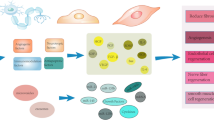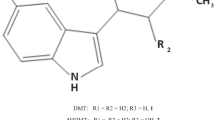Abstract
Pseudoephedrine, an over-the-counter drug, is commonly used for the treatments of asthma, nasal congestion, and obesity. Furthermore, it can be used as a psychostimulant drug if taken in large doses; however, there have been no reports on its effects on reproduction. The aim of this study was therefore to investigate the effects of pseudoephedrine administration on sperm morphology, sperm concentration and apoptotic activity in the rat testis. Rats were administered intraperitoneally (IP) with pseudoephedrine at 120 mg/kg for the acute group and 80 mg/kg, IP, once daily for 15 days for the chronic group, while a control group was treated with vehicle. The percentages of normal sperm morphology were significantly decreased in both acute and chronic groups when compared with controls while the total sperm count was significantly decreased in the acute group. Apoptotic activities were increased significantly in both pseudoephedrine-treated groups. The results indicate that pseudoephedrine can induce sperm abnormalities, decrease sperm numbers and increase apoptotic activity in the testis of rats if taken at high doses. The results of this study suggest that the users of pseudoephedrine in medical treatments need to be aware of its potential toxicity involving spermatogenesis.




Similar content being viewed by others
References
Alavi SH, Taghavi MM, Moallem SA (2008) Evaluation of effects of methamphetamine repeated dosing on proliferation and apoptosis of rat germ cells. Syst Biol Reprod Med 54:85–91
Arafa M, Tabie OE (2008) Medical treatment of retrograde ejaculation in diabetic patients: a hope for spontaneous pregnancy. J Sex Med 5:194–198
Burke BA, Lewis RW, Latenser BA, Chung JY, Willoughby C (2008) Pseudoephedrine legislation decreases methamphetamine laboratory-related burns. J Burn Care Res 29(1):138–140
Chow SH, Giglio W, Anesetti R, Ottenweller JE, Pogach LM, Huang HF (2000) The effects of testicular denervation on spermatogenesis in the Sprague–Dawley rat. Neuroendocrinology 72:37–45
Fazlioglu A, Yilmaz I, Mete O, Kurtulus F, Parlakkilic O, Guctas O, Cek M (2008) The effect of varicocele repair on experimental varicocele-induced testicular germ cell apoptosis. J Androl 29(1):29–34
Mhaouty-Kodja S, Lozach A, Habert R, Tanneux M, Guigon C, Brailly-Tabard S, Maltier JP, Legrand-Maltier C (2007) Fertility and spermatogenesis are altered in α1b-adrenergic receptor knockout male mice. J Endocrinol 195:281–292
Nudmamud-Thanoi S, Thanoi S (2011) Methamphetamine induces abnormal sperm morphology, low sperm concentration and apoptosis in the testis of male rats. Andrologia 43(4):278–282. doi:10.1111/j.1439-0272.2010.01071.x. Epub 2011 Feb 25
Prince FP (1992) Ultrastructural evidence of indirect and direct autonomic innervation of human Leydig cells: comparison of neonatal, childhood and pubertal ages. Cell Tissue Res 269:383–390
Prince FP (1996) Ultrastructural evidence of adrenergic, as well as cholinergic nerve varicosities in the relation to the lamina propria of the human seminiferous tubules during childhood. Tissue Cell 28:507–513
Persky AM, Berry NS, Pollack GM, Brouwer KLR (2004) Modelling the cardiovascular effects of ephedrine. Br J Clin Pharmacol 57:552–561
Tillem SM, Mellinger BC (1999) Azoospermia due to aperistalsis of the vas deferens: successful treatment with pseudoephedrine. Urology 53:417–419
Tong C, Eisenach JC (1992) The vascular mechanism of ephedrine’s beneficial effect on uterine perfusion during pregnancy. Anesthesiology 76:792–708
Tongjaroenbuangam W, Meksuriyen D, Govitrapong P, Kotchabhakdi N, Baldwin BA (1998) Drug discrimination analysis of pseudoephedrine in rats. Pharmacol Biochem Behav 59:505–510
Vernacchio L, Kelly JP, Kaufman DW, Mitchell AA (2008) Pseudoephedrine use among US children, 1999–2006: Results from the Slone survey. Pediatrics 122:1299–1304
Weiner N (1980) Norepinephrine, epinephrine, and the sympathomimetic amines. In: The pharmacologic basis of therapeutics, 6th edn. MacMillan, New York
Wyrobek AJ, Bruce WR (1975) Chemical induction of sperm abnormalities in mice. Proc Natl Acad Sci USA 72(11):4425–4429
Yamamoto Y, Yamamoto K, Hayase T, Abiru H, Shiota K, Mori C (2002) Methamphetamine induces apoptosis in seminiferous tubules in male mice testis. Toxicol Appl Pharmacol 178:155–160
Zhang J, Zhang D, Han X, Yang S (2008) Determination of the synthetic route based on impurity profiling of methamphetamine. Wei Sheng Yan Jiu 37(6):740–744
Author information
Authors and Affiliations
Corresponding author
Additional information
This research was supported by the Thailand Research Fund (TRF) and Commission of Higher Education (CHE), and Naresuan University Research Fund, Naresuan University, Thailand.
Rights and permissions
About this article
Cite this article
Nudmamud-Thanoi, S., Thanoi, S. Pseudoephedrine induces sperm abnormalities, lower sperm counts and increased apoptosis in rat testis. Cell Tissue Res 349, 625–630 (2012). https://doi.org/10.1007/s00441-012-1408-6
Received:
Accepted:
Published:
Issue Date:
DOI: https://doi.org/10.1007/s00441-012-1408-6




